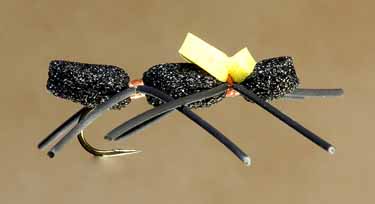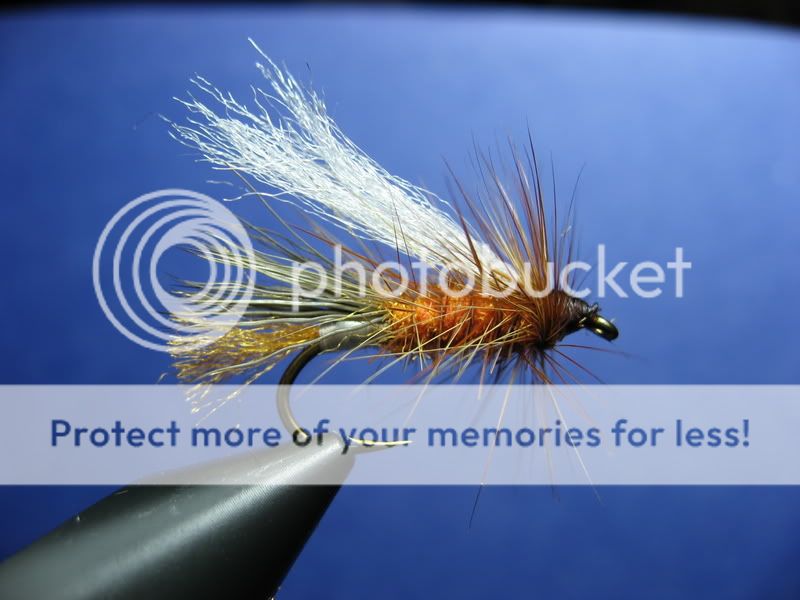Not sure this will become a series of posts, like the title seems to imply. But maybe.
Lately I have been messing around tying the Chubby Chernobyl (see Hopper Juan’s tutorial on tying the fly). I am drawn to this fly for a couple of reasons. First, for a gaudy foam fly it is relatively easy to tie. And ease of tying translates to speed, which is one my prerequisites for any fly. Second, it is showing up in a lot of fishing reports lately. It seems to have usurped its forerunner as one of the of the go-to attractor-terrestrials in the West. Now such status is fickle—this year’s go-to fly will be in the bargain bin a couple of years down the road—but the original Chernobyl Ant has been around a long time (I first encountered it in Jack Dennis’s third book of patterns more than 20 years ago). So maybe the Chernobyl and this new version are more than just the flavor of the month.
Last week, as I was tying up a Chubby Chernobyl, I was struck by how the fly seemed to hold design principles captured by one of my favorite writers/thinkers/philosophers or fly tying—the late great Gary Lafontaine. I’ve written about LaFontaine before, but I am still fascinated by his approach. His opus on floating flies, The Dry Fly: New Angles, was published in 1990. I find this rather incredible because I read the book now, a dozen or so years after the first time I picked it up, and it still seems to be ahead of not only its time, but our time.
LaFontaine intrigues me in part because he took a very scientific approach to understanding why a fish eats a fly. This may seem normal in a sport where everyone knows a bit of Latin and matching the hatch is considered fundamental. But consider two things: (1) most books about fly fishing are based on the personal experiences of the author—which is empirical evidence rather than experimental data, and (2) fly fishing is a sport that lends itself to mystical explanations—complete with religious overtones and that “magic” hour just before dark.
LaFontaine’s approach was to put on scuba gear, dive to the bottom of a pool, and watch trout respond to natural insects and dozens of fakes cast by his team of fly anglers. This was not an attempt at mysticism or magic. This was a way of understanding what was happening beneath the water, the half of the equation that the purists so often cede to the trout, the half of the equation that we understand the least.
The results of this experiment, along with the additional research it spawned, are documented in The Dry Fly: New Angles. There are a ton of interesting insights in this book, some of which seem to come from LaFontaine’s gut, some from the data, and some from a mix of the two. Still, many of the patterns in the book remain outside the mainstream. Flies such as the Airhead, the Mohawk, and the Halo Emerger are often impossible to find in Western fly shops, even though they were field tested by a group of experts and have a track record amongst LaFontaine disciples across the West. Perhaps their inability to catch on comes down to them simply not looking enough like traditional flies, I don’t know. Such a discussion deserves its own post, probably.
Back to the Chubby Chernobyl. One of the most interesting and unique chapters of The Dry Fly is the chapter on attractors. LaFontaine set out to do two things as they performed the research for this chapter. First, figure out why and when flies such as the Royal Wulff are most effective. Second, design a new attractor pattern based on what the research told him.
The answer to the first query is nebulous, as you might guess. Fish are drawn to flies for a seemingly endless number of reasons. But LaFontaine identified two variables that were pretty important: shape and color. He reasons that shape is dependent on water type. That is, certain characteristics of a fly (such as width or height) work better in certain water types. One of the most important characteristics is something LaFontaine referred to as bulk:
“Flies can possess another quality—bulk, or substance—that is more nebulous than mere size, height, or width. Patterns that are bulky (or give that impression) attract trout by promising them a substantial morsel that makes the effort of the chase worthwhile.”
This is, of course, the thinking behind the whole Big Fly = Big Fish theory and perhaps the streamer movement that has taken place over the last dozen years or so (interestingly, Kelly Galloup’s research into streamers and the fish that eat them is exactly the kind of approach I think LaFontaine would have taken). I bring up the bulky idea mainly because LaFontaine was especially fond of bulky flies for flat stretches of water.
The original Chernobyl Ant originated (I believe—please correct me in the comments if I am wrong) on the Green River below Flaming Gorge Dam. It was perhaps designed to imitate a cicada, but it worked (and still works) when there are no cicadas present. It was the first fly I noticed that began to blur the line between a terrestrial and an attractor. It is both wide and bulky. It represents a “substantial morsel.” The Green River is home to many flat water stretches and back eddies where fish have plenty of time to inspect a meal. Since the Chernobyl was first tied, a dozen even crazier foam creations have proved successful on that stream (including the Fat Albert, which takes the bulky idea to and puts it right in the name).

The Original Chernobyl
The Chubby Chernobyl raises the bulky level by tying in a very fat dubbed body under the foam. Viewed from beneath this fly is a wide load. I think LaFontaine would approve.
The second big variable with attractors is color, which LaFontaine explains in monumental detail. Most importantly, he links color directly to light. Just certain shapes work in certain water types, certain colors work better in certain types of light. For instance, in LaFontaine’s experiments, gray flies (such as the Adams) worked better on days with lots of gray light, i.e., cloudy days. I’m not going to dive into this to explicitly, but I suggest you read the book if such things pique your interest.
What is relevant to the Chubby Chernobyl is the attractor that LaFontaine came up with after all this work with color and light. He called it the double wing and its design was a happy accident. The fly has two down wings, one in the front and one in the back. Sound familiar?
The primary difference between the Double Wing and the Chubby Chernobyl wings are the materials. LaFontaine’s fly used a hair wing in the back and a sparkle yarn wing on the front. A Chubby Chernobyl generally has two sparkle wings. LaFontaine claimed the sparkle yarn was useful in exaggerating the sunlight that hit a fly. Describing what the fly looked like from the bottom of the pool, he writes: “Flaring out over the edges of the other parts, the fly’s top wing [the sparkle wing] exploded with reflected light”

A rare photo of LaFontaine’s double wing.
I think this flaring and exploding of light is what sets the Chubby apart from its forerunner and from most foam patterns. While the bulky shape is present in many foam patterns, few seem to have the sparkle wing that the Chubby has in spades. I’m not sure if the designer of the Chubby Chernobyl was a LaFontaine fan, but whoever it was has captured two of LaFontaine’s primary attributes for attractors: shape and color (via light).
Beyond the design, the real uniqueness of the Double Wing is the color series that LaFontaine came up with. He tied the flies in a 11 different color patterns to maximize the light conditions. I think this may be the next step for the Chubby. I noticed my local fly shop carrying the fly in purple and black. I imagine that pink, red, yellow, and green won’t be far behind if they haven’t been introduced already. Perhaps a Royal Chubby is on the horizon as well?
Anyway, if you have read this far, I thank you. This post is convoluted and different than the kind of thing I generally write. But I tend to find fly design fascinating and I couldn’t help myself here once some of the connections dawned on me. Good luck tossing massive foam creations at fish over the next month or so. Maybe this post sheds some light on why the Chubby works, or maybe the fish just take it for a hopper or a nocturnal stone, which is entirely possible but not nearly as much fun.
Image credit: The Chubby Chernobyl via The Hopper Talk Blog.


